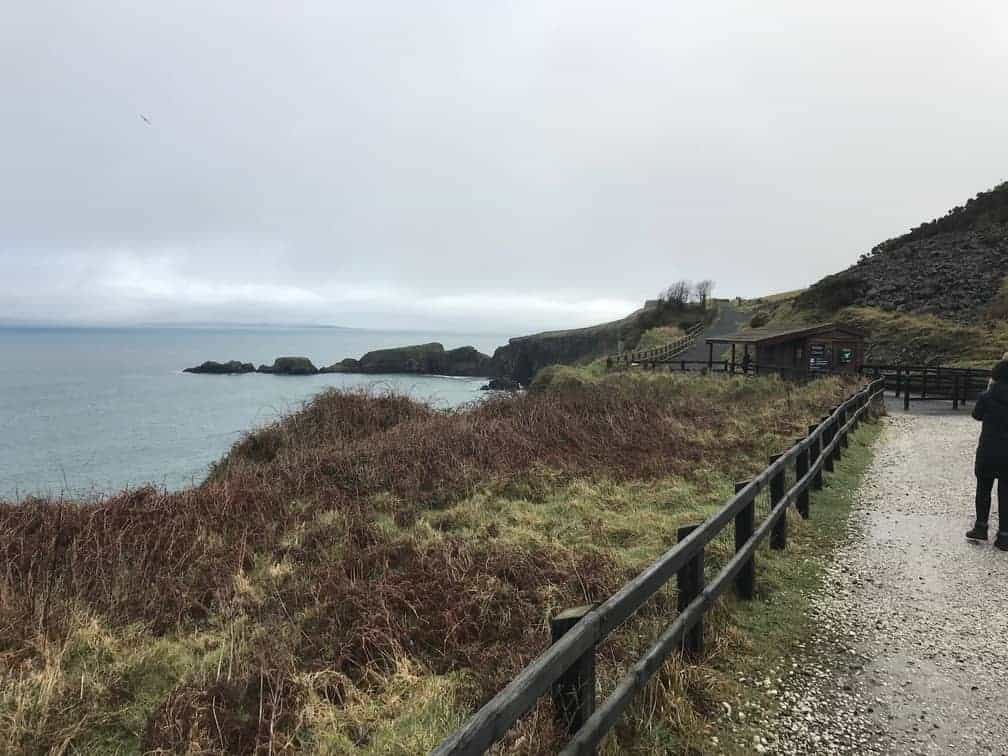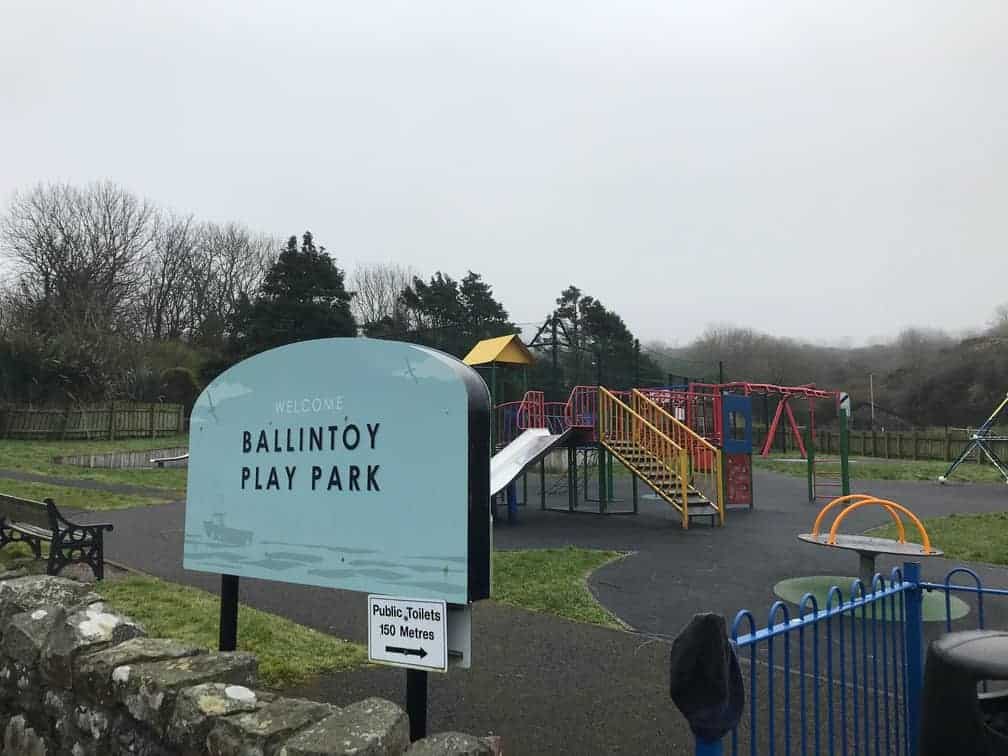Carrick a rede rope bridge
Located around 8 miles from the Giants Causeway, along the Causeway coast, close to Ballintoy in Northern Ireland, Carrick a Rede Rope Bridge is a suspension bridge originally made from rope that links Carrick Island to the mainland. This unique Carrick a Rede connected feature highlights the dramatic link between the island and the cliffs, offering a memorable scenic experience.
This site is on the world-famous Causeway Coast Route County Antrim, Northern Ireland and is maintained and owned by the conservation charity The National Trust. Nowadays, the bridge is open as a tourist attraction, with nearly half a million people crossing the rope bridge in 2019.
To enjoy an exciting clifftop experience visit the rope bridge to Carrick a Rede island on the Causeway Coast. This 20-metre-across and 30-metre-deep chasm above the Atlantic Ocean is crossed by the rope bridge salmon fishermen initially built, suspended 30 metres above sea level. Individuals brave enough to walk across the bridge to the rocky island are rewarded with fantastic views. Carrick-a-Rede Island serves as the final destination, offering visitors the ultimate reward of stunning scenery, wildlife, and historical features.
The famous rope bridge Carrick-a-Rede in is a must-visit for anyone in the area. It offers breathtaking views and a thrilling height not for the faint-hearted. Located on the Causeway Coastal Route near Ballycastle, the bridge’s name comes from the Scottish Gaelic ‘Carraig-a-Rade’, meaning ‘The Rock in the Road. The bridge was named after fishermen who caught Atlantic salmon from the island in 1755.
What is the Carrick a Rede rope bridge?
The bridge connects the mainland and the Island of Carrick-a-Rede. It comprises planks, wire, rope, and netting and is suspended 100 feet in the air, crossing 60 across the water. The rope bridge crossing offers a thrilling and adventurous experience, with breathtaking views and the excitement of traversing this historic suspension bridge. The Trust manages and maintains the rope bridge, ensuring its safety for crossing and other areas that protect ongoing conservation.
How long is the Carrick a Rede rope bridge?
The Carrick-a-Rede Rope Bridge is located near Ballintoy in County Antrim, Northern Ireland. It serves as a link between the mainland and Carrick Island and has a length of 20 metres (66 ft) and a height of 30 metres (98 ft) above the ocean and rocks. From the bridge, visitors can enjoy lovely views of the surrounding coastline and ocean.
The Carrick-a-Rede Rope Bridge was used as a filming location in Game of Thrones for the scene where Balon Greyjoy is killed by his younger brother Euron. The scene occurs on the bridge between the two towers of Pyke after an argument with his daughter, Yara.
How to get to Carrick-a-Rede rope bridge
The best way to get to the bridge is to journey from Belfast along the Causeway Coastal Route or through Glens of Antrim, both routes are relatively easy and take about an hour each. As you approach Ballintoy, follow Whitepark Road, a key route near Carrick-a-Rede, which leads you close to the famous site. We recommended driving through the glens to witness the stunning Irish forests, waterfalls, and coastal scenery.
To access Carrick-A-Rede’s rope bridge via public transport, you can take a train or bus from Belfast to Coleraine and choose one of two buses close to the Bridge. However, a 20-minute walk from the bus stop is necessary to reach the Bridge.
Top tips for visiting the Carrick-a-Rede Rope Bridge
Is the Carrick-a-Rede Rope Bridge safe?
The Bridge is well-maintained and closed during bad weather or windy days. It can be nerve-racking due to its bounciness and consists of two wooden planks on woven wire supports. It is not recommended for those with mobility issues, fear of heights, or balance problems. Children under eight should not cross the bridge, although no age limits exist.
Carrick-a-Rede Car Park
Behind the small cafe and gift shop at Carrick-a-rede, there is spacious free parking with a number of marked spaces in the small car park. The shop offers postcards and trinkets for purchase and also provides a convenient spot to grab a snack and coffee before crossing the bridge.
Campervan guidance: Visitors arriving in campervans or motorhomes will find a limited number of designated campervan spaces available in the main car park. These spaces are allocated on a first serve basis, and overnight parking is not permitted for campervans or motorhomes. Please note that parking fees, if applicable, can be paid by card payment for added convenience.
There is an overflow car park further down in the quarry, providing additional parking spaces. This car park is generally only open at busy times and is not paved.
Facilities
At the car park, there is a cafe called the Weighbridge Cafe. It has a small coffee shop that’s warm with a range of hot and cold drinks. After exploring the site, visitors can relax and enjoy a savoury treat or a sweet or savoury treat from the cafe to complete their visit.
Tickets for the Carrick-a-Rede Rope Bridge
How to buy Tickets for the Carrick-a-Rede Rope Bridge
To buy your tickets for Carrick a Rede, you have two options.
On-site: This can be done at the ticket office next to the car park. However, do this as early as possible on the day of your visit or just ‘wing it’ and try your luck. A sign at the entrance lets you know when the next crossing tickets are available or if tickets have been sold out for the day.
Online: You can buy tickets here. You’ll get a digital ticket emailed. You can then either print it out or show them your phone.
Either way, give yourself time to arrive at the bridge from whatever experience you are coming from. And check the weather; they will close the Rope Bridge if it is too windy.
Do I have to pay to visit the Carrick-a-Rede Rope Bridge?
No. If you only want to see the rope bridge, then it does not cost anything to walk down; however, if you want to cross the rope bridge onto the island, then tickets are required.
Buying tickets for the bridge in advance is best during peak tourism season. The bridge can get over 2000 visitors daily, and tickets are timed for your crossing. You should book tickets online at the National Trust because they’re limited. After booking, you will receive an email and can pick up your printed ticket at the site.
An alternate route to the viewpoint doesn’t require crossing the bridge. You can choose to walk along the coastal path at no cost.
How much does it cost to cross Carrick a Rede rope bridge?
Tickets are required to cross the Carrick a Rede rope bridge.
Adult tickets cost £13.00
Child tickets are £6.50 for ages 5 to 17
A family ticket costs £32.50.
You can cross for Free if you are a National Trust Member, this includes national trust members from other countries Walking to the bridge is free, but crossing it requires a ticket.
How long to spend at Carrick a Rede?
The walk to the bridge and crossing to Carrick a Rede Island typically take 3-4 hours, allowing ample enjoyment of the scenery. Measures such as timed tickets and accessible facilities are in place, aimed at improving everyone’s experience during their visit.
How long is the walk to Carrick a Rede rope bridge?

Reaching the viewpoint at Carrick-a-rede from the parking lot takes around 20-30 minutes of walking. The distance is about 1km. The walk is not challenging for most people, but it’s not advisable if you have mobility issues. The pathway is made of gravel and has some slight inclines. There are also 30 steep steps leading down to the bridge entry. Walking to the bridge entry point is free of charge.
It may not be advisable to bring small children who tend to wander or those in strollers who cannot navigate gravel paths. As shown in the article’s photos, the paths can be steep and only have ropes as barriers.
Is the Carrick-a-Rede rope bridge safe?
It was designed to support the weight of many people crossing the bridge simultaneously and undergo regular safety inspections.
The bridge is generally considered safe for visitors to cross, but those with a fear of heights or unsteady footing may find it challenging. It is essential to follow all posted guidelines and listen to the staff’s instructions on-site to ensure a safe and enjoyable visit.
History of Carrick-a-Rede Rope Bridge
The construction of the first rope bridge to Carrick-a-Rede Island in 1755, a simple rope bridge with only one handrail, aimed to lessen the dependence on boats to reach the island. The island was used for salmon fishing from 1755 to 2002, but the fishing trade declined due to pollution and overfishing.
Alex ‘Achi’ Colgan was the last fisherman to work at Carrick-a-rede, where he and his uncle had been fishing for over 30 years. At over 80 years old, he describes it as the most challenging salmon fishery on the coast, with a daily catch of 250 or more.
What to see on The Island
There is little to do once on the island; the real attraction is crossing the bridge. However, the views on a clear day are fantastic. You can see Rathin Island, Isaly, Mull of Kintyre, and the Causeway Coast; it is a gorgeous spot for a picnic.
The Salmon Fishery
As you cross over the current bridge, you will see the tiny fisherman’s cottage and ice house of the salmon fishery near the island’s base.
The salmon fishery was the reason the bridge and cottage were built. The fishermen were known to catch over 10,000 wild Atlantic salmon in their nets daily. The salmon fishery was in use right up until the early 2000s.
The Salmon Fishermen Cottage is only open one weekend each month, but it’s worth finding out when this is. The National Trust has friendly staff and volunteers to take you into the cottage and share the stories of the bridge, the island, and the Causeway Coast – with a fish tale or two thrown in.
Leaving the small fishing island
The rope bridge is a ‘one-way’ system, so you’ll likely have to wait to cross back. This is a perfect opportunity to get that selfie with the bridge in the background. The path to the left of the steps you initially came down has some of the best views of the rope bridge and island.
For a small fee, you can get your official ‘Over the Bridge’ certificate from the visitor centre to get the documented proof of your crossing!
Opposite the entrance to the visitor centre is the cafe, where you can stop off for tea/coffee and a bun- they are delicious, and you earned it after that walk!
Fisherman’s Cottage
Perched on Carrick-a-Rede Island, the Fisherman’s Cottage is a remarkable reminder of the island’s storied past. This single building, once home to generations of salmon fishermen, stands as a tribute to the resilience and ingenuity of those who first built and maintained the iconic rope bridge. Facing the wild Atlantic Ocean, the cottage provided shelter and a base for the fishermen who braved unpredictable weather and treacherous seas to harvest the rich salmon stocks that once thrived here. Today, visitors to Carrick-a-Rede Island can step inside the cottage and imagine the daily lives of these hardy individuals, gaining a unique perspective on the challenges and triumphs that shaped the history of the bridge and the island. Exploring the Fisherman’s Cottage is a must for anyone interested in the heritage of Carrick, offering a tangible connection to the people who made this dramatic coastal site what it is today.
National Trust and Conservation
Carrick-a-Rede is proudly managed by the National Trust, a leading conservation charity dedicated to preserving the site’s natural beauty and historical significance. Since taking stewardship of the rope bridge and surrounding area, the National Trust has worked tirelessly to protect the unique landscape, wildlife, and heritage of Carrick. The site is now recognized as an Area of Special Scientific Interest, reflecting its importance for geology, flora, and fauna. Conservation efforts include regular maintenance of the rope bridge, safeguarding the island’s habitats, and promoting responsible tourism to ensure that visitor numbers are spread sustainably throughout the year. National Trust members and local pass holders enjoy free access to the site, but all visitors—including those with passes—must pre-book their Visitor Experience tickets in advance to help manage access and preserve the site for future generations. By supporting the National Trust, every visitor plays a part in protecting Carrick-a-Rede’s legacy and ensuring this breathtaking destination remains open for all to enjoy.
Coastal Walk and Scenic Views
The journey to Carrick-a-Rede Rope Bridge is as memorable as the crossing itself, thanks to the spectacular coastal walk that hugs the cliffs of Northern Ireland’s Causeway Coast. This scenic trail, approximately 1.5 miles roundtrip, offers visitors sweeping views of the Atlantic Ocean, dramatic cliffs, and the rugged beauty of the surrounding area. Along the way, you’ll find an accessible telescope at a dedicated viewing point, perfect for taking in the stunning views of Rathlin Island and, on clear days, even the distant Scottish Isles. The coastal path is well-maintained and suitable for families, with the first section designed to be accessible for all. As you walk, keep an eye out for seabirds and local wildlife, and take time to pause and soak in the beautiful coastal scenery that makes this part of Northern Ireland so special. Whether you’re an avid photographer or simply love a good walk, the coastal trails leading to the rede rope bridge promise an unforgettable experience.
Accessibility
Carrick-a-Rede is committed to making the site as accessible as possible, ensuring that everyone can enjoy the breathtaking views and unique experience of the rope bridge. The main visitor car park offers convenient onsite parking, and the first 0.5km of the coastal path is accessible, featuring a smooth surface and an accessible telescope at the viewing point for panoramic sea views. For visitors with mobility needs, a manual wheelchair is available to borrow from the Tearoom on a first-come, first-served basis. The site also recognizes sensory needs, offering sensory bags—complete with ear defenders, an emotion fan, fidget items, and a cuddly toy—which can be borrowed from the Booking Hut in the main visitor car park. While the final approach to the bridge includes steeper slopes and two long sets of steps, the National Trust is continually working to improve access and provide a welcoming environment for all. For the latest information on accessibility, including guidance for visitors with specific requirements, check the official Carrick-a-Rede website before your visit.
Ballintoy Park

If you are like us and have kids with you, then the island may not be for them. So we highly recommend taking them to the nearby park at Ballintoy. It’s only a short walk back up the hill and has a range of playthings and a sports cage for them to let off steam. It is a good place to sit, have a cup of tea, and relax while the kids play….they love a park!
Nearby Attractions
The Giant’s Causeway – The Giant’s Causeway is a must-visit site in Northern Ireland, renowned for its unique basalt columns and natural beauty. Alongside the Carrick-a-Rede Rope Bridge, it stands out as one of the region’s most iconic attractions.

